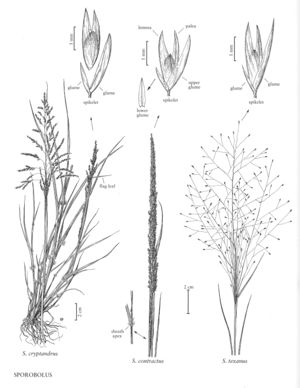Difference between revisions of "Sporobolus contractus"
FNA>Volume Importer |
FNA>Volume Importer |
||
| Line 20: | Line 20: | ||
-->{{Treatment/Body | -->{{Treatment/Body | ||
|distribution=Maine;N.J.;Mich.;Wash.;N.Mex.;Tex.;Utah;Calif.;Okla.;N.Y.;Colo.;Ariz.;Nev.;Conn. | |distribution=Maine;N.J.;Mich.;Wash.;N.Mex.;Tex.;Utah;Calif.;Okla.;N.Y.;Colo.;Ariz.;Nev.;Conn. | ||
| − | |discussion=<p>Sporobolus contractus grows in dry to moist, sandy soils, at elevations from 300-2300 m. It is found occasionally in salt-desert scrub, desert grasslands, and pinyon-juniper woodlands. Its range extends to the states of Baja California and Sonora in Mexico.</p> | + | |discussion=<p><i>Sporobolus contractus</i> grows in dry to moist, sandy soils, at elevations from 300-2300 m. It is found occasionally in salt-desert scrub, desert grasslands, and pinyon-juniper woodlands. Its range extends to the states of Baja California and Sonora in Mexico.</p> |
|tables= | |tables= | ||
|references= | |references= | ||
| Line 41: | Line 41: | ||
|publication year= | |publication year= | ||
|special status= | |special status= | ||
| − | |source xml=https://jpend@bitbucket.org/aafc-mbb/fna-data-curation.git/src/ | + | |source xml=https://jpend@bitbucket.org/aafc-mbb/fna-data-curation.git/src/8f726806613d60c220dc4493de13607dd3150896/coarse_grained_fna_xml/V25/V25_681.xml |
|subfamily=Poaceae subfam. Chloridoideae | |subfamily=Poaceae subfam. Chloridoideae | ||
|tribe=Poaceae tribe Cynodonteae | |tribe=Poaceae tribe Cynodonteae | ||
Revision as of 16:33, 18 September 2019
Plants perennial; cespitose, not rhizomatous. Culms 40-100 (120) cm tall, 2-4(5) mm thick near the base. Sheaths rounded below, margins hairy, partic¬ularly distally, hairs to 3 mm, apices with conspicuous tufts of hair; ligules 0.4-1 mm; blades (2)4-35 cm long, 3-8 mm wide, flat to involute, glabrous on both surfaces, margins whitish, somewhat scabridulous. Panicles all terminal, (10)15-45(50) cm long, 0.2-0.8(1) cm wide, contracted, spikelike, dense, usually included in the uppermost sheath; lower nodes with 1-2(3) branches; primary branches 0.3-1.5 cm, appressed, spikelet-bearing to the base; secondary branches appressed; pulvini glabrous; pedicels 0.2-2 mm, appressed, scabridulous. Spikelets 1.7-3.2 mm, whitish to plumbeous. Glumes unequal, narrowly lanceolate, membranous, prominently keeled; lower glumes 0.7-1.7 mm, usually 1-veined, acute to acuminate; upper glumes 2-3.2 mm, at least 2/3 as long as the florets; lemmas 2-3.2 mm, linear-lanceolate, membranous, glabrous, acute; paleas 1.8-3 mm, linear-lanceolate, membranous, glabrous; anthers 3, 0.3-0.5 mm, light yellowish. Fruits 0.8-1.2 mm, ellipsoid, laterally flattened, light brownish or translucent. 2n = 36.
Distribution
Maine, N.J., Mich., Wash., N.Mex., Tex., Utah, Calif., Okla., N.Y., Colo., Ariz., Nev., Conn.
Discussion
Sporobolus contractus grows in dry to moist, sandy soils, at elevations from 300-2300 m. It is found occasionally in salt-desert scrub, desert grasslands, and pinyon-juniper woodlands. Its range extends to the states of Baja California and Sonora in Mexico.
Selected References
None.
